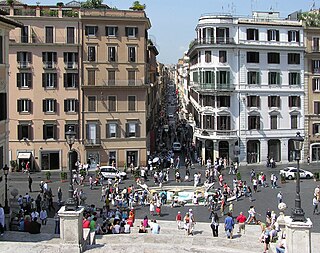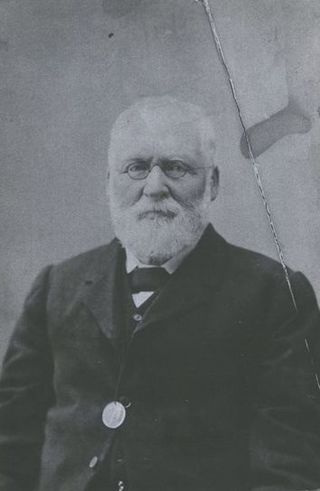
Babington's tea room, established in 1893, is a traditional English tea shop at the foot of the Spanish Steps in the Piazza di Spagna in Rome, Italy.

Babington's tea room, established in 1893, is a traditional English tea shop at the foot of the Spanish Steps in the Piazza di Spagna in Rome, Italy.
The tea room was founded by two young women, one from New Zealand and one from England, who arrived in Rome in 1893. They were Isabel Cargill, daughter of William Cargill, founder of the city of Dunedin in New Zealand and Anna Maria Babington, descendant of Anthony Babington who was hanged in 1586 for conspiring against Elizabeth I. The women decided to invest their savings (100 pounds) by opening a tea and reading room in the capital for the Anglo-Saxon community. [1] The venture at the time involved considerable risks, above all because in Italy it was not common to drink tea, which was sold only in pharmacies.
Babington's tea room was an immediate success, both because Italy was the destination of the Grand Tour for the English and because it was part of a Rome that celebrated the Jubilee and the silver wedding of the royals Umberto and Margherita.
Originally the tea room was on Via dei Due Macelli, a sideroad of the Piazza di Spagna, but the establishment's success encouraged the owners to relocate to the Piazza di Spagna 23. [2] [3] [4] It is located on the ground floor of an 18th-century building from which one can see the Spanish Steps, the staircase of the Trinità dei Monti church.
These buildings are the original stables of the 18th century palazzo designed by Francesco De Sanctis, architect of the Spanish Steps.
The new tea room on the Piazza di Spagna was furnished elegantly and became, according to the English language Roman Herald, a favoured meeting place "where ladies or gentlemen, hard at work sightseeing could go to refresh themselves with a comforting cup of tea." [5]
During the First World War, Rome society plunged into depression but the tea room survived. Cargill's sister Annie invested her life's savings to give the premises a complete renovation. Anna Maria Babington moved to Switzerland because of her failing health, and died of a heart attack in 1929.
Despite the anti-English policy of Mussolini, throughout the fascist period and even during the Second World War, Babington's remained open, with its very clear sign in English and solid bronze characters on a Roman travertine plaque. [6]
During the 1950s and 1960s, with the success of Cinecittà, film stars and other celebrities frequented the tea room, some even as regulars, including Richard Burton and Liz Taylor, Charlton Heston, Robert Taylor, Peter Ustinov, Audrey Hepburn and filmmaker Federico Fellini. [7]
The Babington's staff had a regular cat guest, Mascherino, who was a stray Roman cat adopted in the late 1950s and became the tearoom's mascot. [8]
Babington's staff still serve Victoria Afternoon Tea in uniform. [9] One of the tea blenders is Melania Francis Lopez, who created the Royal Wedding blend. [10]
Babington's survived two World Wars, the advent of fast food and various economic crises, to become a Roman institution and tourist attraction. The tea room is run by the fourth generation descendant of Isabel Cargill. [11] [12] [13]

The Capitolium or Capitoline Hill, between the Forum and the Campus Martius, is one of the Seven Hills of Rome.

The Spanish Steps in Rome, Italy, climb a steep slope between Piazza di Spagna at the base and Piazza Trinità dei Monti, dominated by the Trinità dei Monti church, at the top.

The Congregation for the Evangelization of Peoples was a congregation of the Roman Curia of the Catholic Church in Rome, responsible for missionary work and related activities. It is also known by its former title, the Sacred Congregation for the Propagation of the Faith, or simply the Propaganda Fide. On 5 June 2022, it was merged with the Pontifical Council for Promoting the New Evangelization into the Dicastery for Evangelization.

The Piazza di Spagna is a square in the centre of Rome, the capital of Italy. It lies at the foot of the Spanish Steps and owes its name to the Palazzo di Spagna, the seat of the Embassy of Spain to the Holy See. The Column of the Immaculate Conception is in the square.

Villa Borghese is a landscape garden in Rome, containing a number of buildings, museums and attractions. It is the third-largest public park in Rome, after the ones of the Villa Doria Pamphili and Villa Ada. The gardens were developed for the Villa Borghese Pinciana, built by the architect Flaminio Ponzio, developing sketches by Scipione Borghese, who used it as a villa suburbana, or party villa, at the edge of Rome, and to house his art collection. The gardens as they are now were remade in the late 19th century.

William Walter Cargill was the founder of the Otago settlement in New Zealand, after serving as an officer in the British Army. He was a member of parliament and Otago's first Superintendent.

Borgo is the 14th rione of Rome, Italy. It is identified by the initials R. XIV and is included within Municipio I.

Piazza del Popolo is a large urban square in Rome. The name in modern Italian literally means "People's Square", but historically it derives from the poplars after which the church of Santa Maria del Popolo, in the northeast corner of the piazza, takes its name.

Rocco Barocco is a fashion designer.
Montemagno is a comune (municipality) in the Province of Asti in the Italian region Piedmont, located about 50 kilometres (31 mi) east of Turin and about 13 kilometres (8 mi) northeast of Asti. As of 31 December 2010 it had a population of 1,228 and an area of 15.9 square kilometres (6.1 sq mi).

The Fontana della Barcaccia is a Baroque-style fountain found at the foot of the Spanish Steps in Rome's Piazza di Spagna. Pope Urban VIII commissioned Pietro Bernini in 1623 to build the fountain as part of a prior Papal project to erect a fountain in every major piazza in Rome. The fountain was completed between 1627 and 1629 by Pietro possibly along with the help of his son Gian Lorenzo Bernini, especially after his father's death on August 29, 1629.

Via dei Condotti is a busy and fashionable street of Rome, Italy. In Roman times it was one of the streets that crossed the ancient Via Flaminia and enabled people who transversed the Tiber to reach the Pincio hill. It begins at the foot of the Spanish Steps and is named after conduits or channels which carried water to the Baths of Agrippa. Today, it is the street which contains the greatest number of Rome-based Italian fashion retailers. It is one of the most expensive streets in Europe, it is located within the Tridente, connecting Via del Corso to Piazza di Spagna.

Via del Babuino is a street in the historic centre of Rome (Italy), located in the rione Campo Marzio. It connects Piazza del Popolo to Piazza di Spagna and is part of the complex of streets known as Tridente.

The Keats–Shelley Memorial House is a writer's house museum in Rome, Italy, commemorating the Romantic poets John Keats and Percy Bysshe Shelley. The museum houses one of the world's most extensive collections of memorabilia, letters, manuscripts, and paintings relating to Keats and Shelley, as well as Byron, Wordsworth, Robert Browning, Elizabeth Barrett Browning, Oscar Wilde, and others. It is located on the second floor of the building situated just to the south of the base of the Spanish Steps and east of the Piazza di Spagna.

The Palazzo di Propaganda Fide is a palace located in Rome, designed by Gian Lorenzo Bernini, then Francesco Borromini. Since 1626, it has housed the Congregation for the Evangelization of Peoples and since 1929 is an extraterritorial property of the Holy See. The complex includes a dormitory and chapel as well.

Edward Bowes Cargill was a 19th-century businessman and Member of Parliament in Dunedin, Otago, New Zealand. He was the Mayor of Dunedin from 1897 to 1898.
The Collegio S. Giuseppe-Istituto de Mérode is a Catholic school of the Brothers of the Christian Schools. It is located in Rome, Italy, in via San Sebastianello 1, at the corner of Piazza di Spagna, in the rione Campo Marzio. It comprises two buildings, the Collegio S. Giuseppe and the Istituto de Mérode. It includes a primary school, middle school and high school.

The Palazzo di Spagna is a Baroque palace in the Piazza di Spagna in Rome. It has housed the Embassy of Spain to the Holy See since 1647, and was bought by the Spanish crown in 1654. It previously belonged to the Monaldeschi family, and so was known as Palazzo Monaldeschi.
Isabel Cargill was a New Zealand businesswoman who established English-style tearooms in Rome, Italy, in the early 1890s.